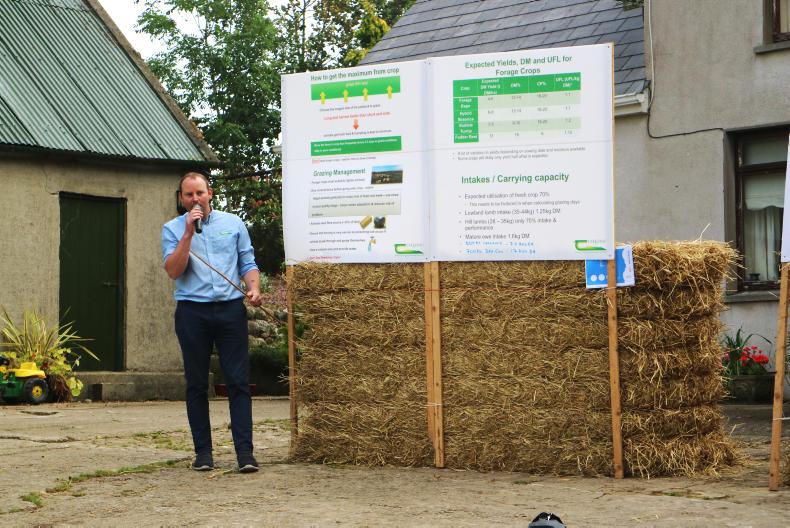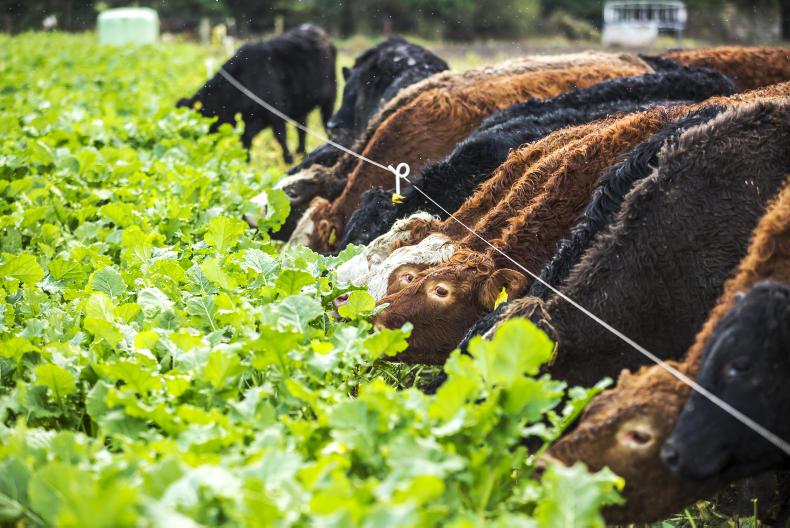The focus of Tuesday's Teagasc catch crop and drilling demonstration event in Wexford was to examine the benefits of growing catch crops and explore different establishment techniques.
Catch crops can serve a number of purposes.
The first is to capture nutrients and provide ground cover over the winter. If incorporated, this will also help build soil organic matter over time.
Another potential use is to provide fodder to livestock over the winter period. Many growers planted fodder crops last year in response to fodder shortages, providing feed for the livestock industry long into the winter. Key fodder crops grown last year included fodder rape, leafy turnip and ryegrass.
But are there markets for fodder crops this year? The Irish Farmers Journal spoke to James Doran, drystock adviser with Teagasc, about the market for fodder crops this year.

Teagasc drystock adviser James Doran speaking at the catch crop and drilling demonstration event.
He acknowledged the increase in fodder supplies this season and said that this will be a factor in determining the value to your fodder crop this year.
Feeding fodder crops remains a good option for livestock farmers, however, due to their high protein and energy content. Doran stressed that livestock need to be gradually introduced to a fodder crop diet, supplementing straw or silage into their diet for fibre.
How do you place a value on the crop given the increases in fodder availability this year? Listen to the full interview with James below to find out:
Read more
Options for coping with straw in a wet year
Cereal harvest estimated at 2.1m tonnes
The focus of Tuesday's Teagasc catch crop and drilling demonstration event in Wexford was to examine the benefits of growing catch crops and explore different establishment techniques.
Catch crops can serve a number of purposes.
The first is to capture nutrients and provide ground cover over the winter. If incorporated, this will also help build soil organic matter over time.
Another potential use is to provide fodder to livestock over the winter period. Many growers planted fodder crops last year in response to fodder shortages, providing feed for the livestock industry long into the winter. Key fodder crops grown last year included fodder rape, leafy turnip and ryegrass.
But are there markets for fodder crops this year? The Irish Farmers Journal spoke to James Doran, drystock adviser with Teagasc, about the market for fodder crops this year.

Teagasc drystock adviser James Doran speaking at the catch crop and drilling demonstration event.
He acknowledged the increase in fodder supplies this season and said that this will be a factor in determining the value to your fodder crop this year.
Feeding fodder crops remains a good option for livestock farmers, however, due to their high protein and energy content. Doran stressed that livestock need to be gradually introduced to a fodder crop diet, supplementing straw or silage into their diet for fibre.
How do you place a value on the crop given the increases in fodder availability this year? Listen to the full interview with James below to find out:
Read more
Options for coping with straw in a wet year
Cereal harvest estimated at 2.1m tonnes







 This is a subscriber-only article
This is a subscriber-only article











SHARING OPTIONS: